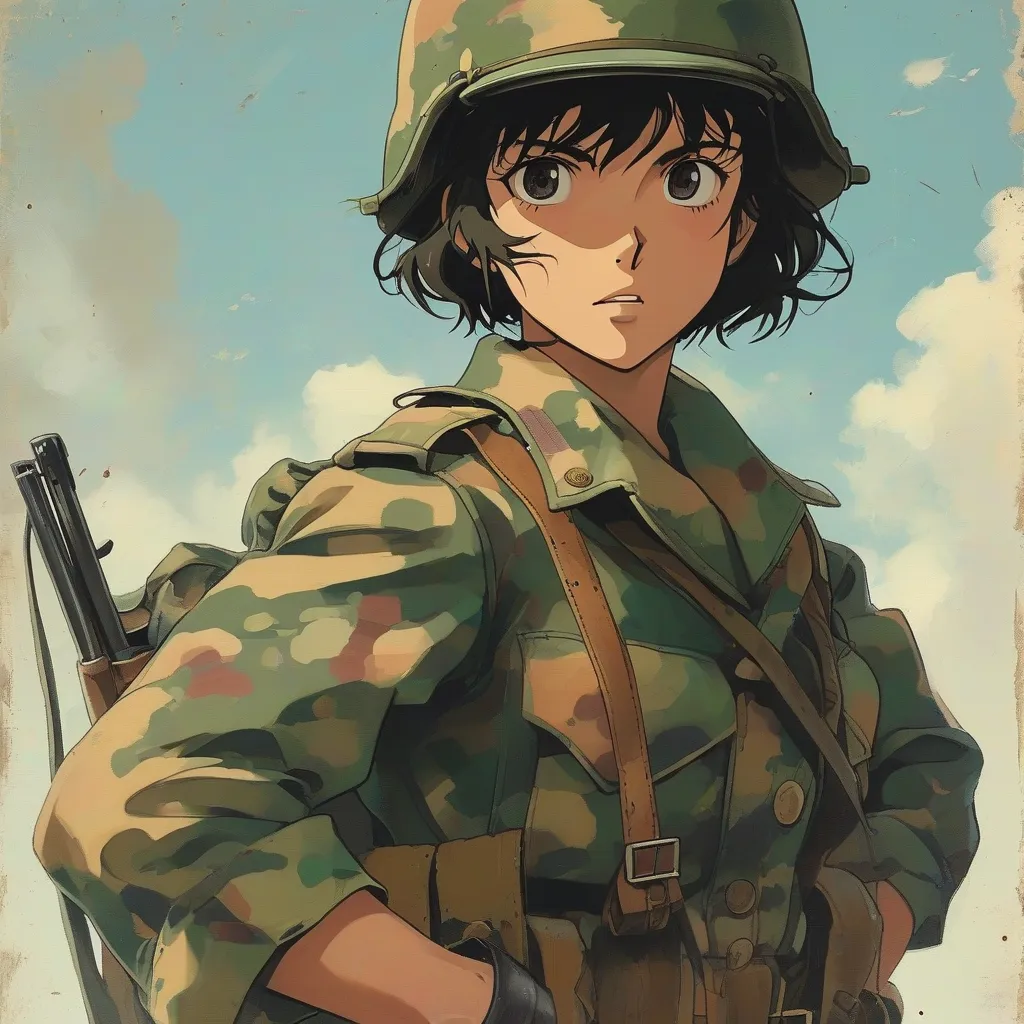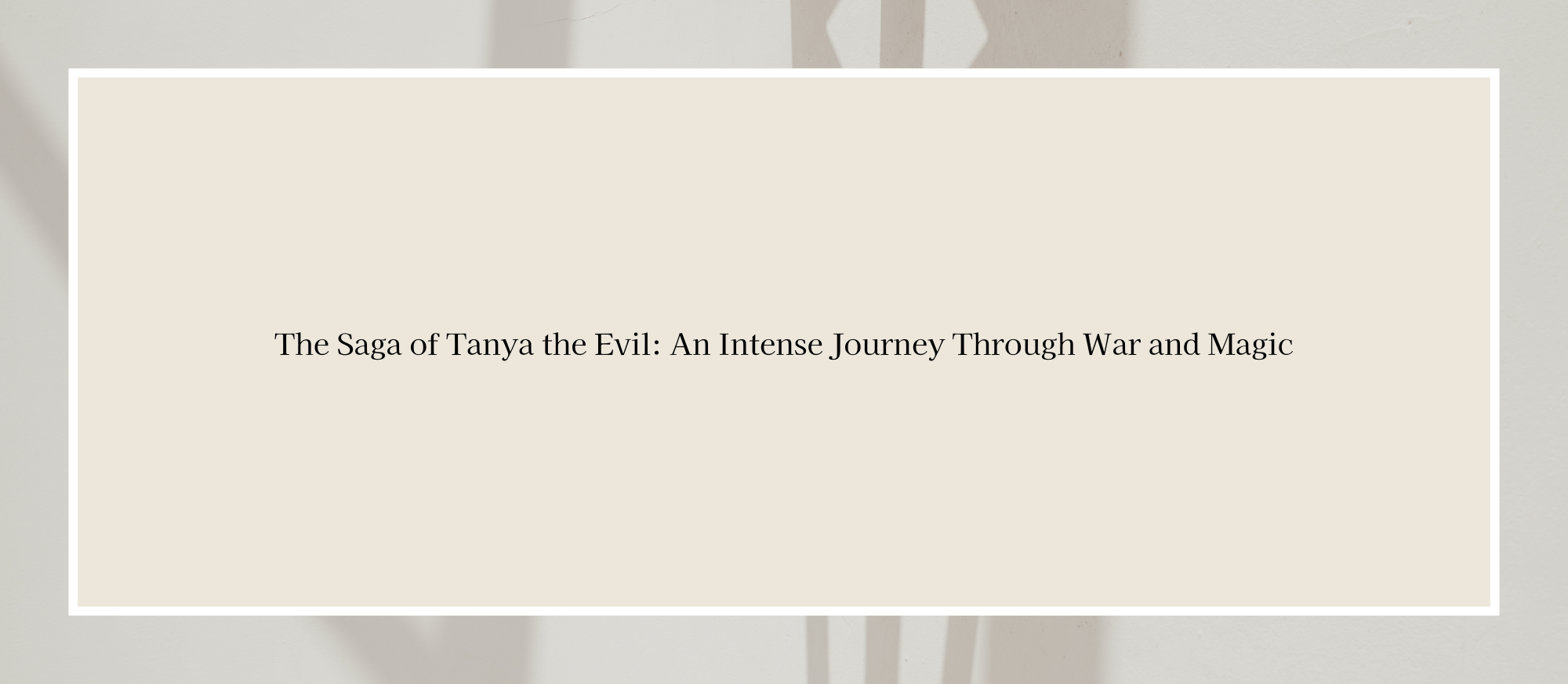Article Outline:
- Introduction to The Saga of Tanya the Evil
- Provide an overview of the anime, including its release date, production studio (NUT), and central premise.
- Highlight the story’s unique concept of reincarnation and the military/magic fusion that drives the plot.
- Mention the appeal of the series to fans of dark fantasy and war-themed anime.
- Plot Overview and Key Story Arcs
- Outline the main storyline, focusing on Tanya Degurechaff’s rise within the military ranks.
- Discuss key story arcs, including her battles, strategic maneuvers, and her conflict with Being X.
- Emphasize the themes of survival, power, and fate that resonate throughout the series.
- Character Profiles and Development
- Introduce the main characters, including Tanya Degurechaff and her comrades.
- Explore Tanya’s complex personality, motivations, and her ruthless nature.
- Discuss how supporting characters, such as Viktoriya Ivanovna Serebryakov, add depth to the narrative.
- Animation, Visuals, and Battle Scenes
- Highlight the high-quality animation and visuals, particularly during intense battle scenes.
- Discuss the use of magic and military tactics in the animation, and how it enhances the storytelling.
- Mention the artistic choices that set the series apart from other war-themed anime.
- Cultural Impact and Reception
- Analyze the reception of The Saga of Tanya the Evil among anime fans and critics, both in Japan and internationally.
- Discuss the series' impact on the dark fantasy genre and its growing popularity.
- Highlight any awards, recognitions, or fanbase growth that have contributed to the series’ lasting influence.
Contents
Introduction to The Saga of Tanya the Evil

Released in January 2017, The Saga of Tanya the Evil is an anime produced by Studio NUT that blends dark fantasy with military action. The story follows a ruthless Japanese salaryman who, after angering a mysterious being known as "Being X," is reincarnated as a young girl named Tanya Degurechaff in an alternate war-torn world. This world is a unique fusion of magic and military conflict, where Tanya must climb the ranks of the Imperial Army while battling powerful enemies on the front lines.
What makes The Saga of Tanya the Evil particularly intriguing is its unconventional protagonist. Despite her young appearance, Tanya is cold, calculating, and driven by a fierce desire to survive in a world filled with danger. The series delves into themes of reincarnation, fate, and the struggle for power, making it a compelling watch for fans of dark fantasy and war-themed anime.
The show’s combination of intense battle scenes, strategic military maneuvers, and the supernatural presence of magic adds depth to the story. The fusion of military tactics with magical abilities creates a unique setting that sets The Saga of Tanya the Evil apart from typical fantasy anime. Viewers are drawn to the high stakes and unpredictable twists that keep the tension alive throughout the series.
For fans of anime that explore darker themes and moral ambiguity, The Saga of Tanya the Evil offers a thought-provoking narrative. The protagonist’s internal battle with faith, fate, and survival in a war-torn world adds complexity to her character, making the series an unforgettable experience. Whether you’re drawn to the intense action or the intricate story, this anime has something for every fan of dark fantasy and military drama.
Plot Overview and Key Story Arcs

The Saga of Tanya the Evil follows the rise of Tanya Degurechaff, a young girl with an extraordinary military career in a world where magic and warfare intertwine. Reincarnated from a salaryman into this world by the mysterious "Being X," Tanya uses her ruthless intelligence and military prowess to climb the ranks of the Imperial Army. Despite her childlike appearance, she becomes a formidable force on the battlefield, mastering both strategic maneuvers and magical combat.
The story arcs in The Saga of Tanya the Evil are defined by Tanya’s relentless pursuit of power and survival. Key battles showcase her ability to turn the tide of war, often against overwhelming odds. Her tactical genius is put to the test as she faces rival nations and their powerful magic users. These intense conflicts emphasize her desire to outwit her enemies, even as the odds stack against her.
A central conflict in the series revolves around Tanya’s ongoing struggle with Being X, the deity responsible for her reincarnation. Being X forces her into a position where she must rely on faith, despite her atheistic beliefs, to survive in a brutal world. This philosophical battle between free will and divine intervention adds depth to the narrative, exploring themes of fate and power.
Throughout the series, the themes of survival and the pursuit of power are ever-present. Tanya’s journey is a testament to her resilience in a world that constantly threatens her existence. Her character embodies the harsh realities of war, where only the strongest and most cunning can survive. The series deftly balances action-packed sequences with deeper reflections on morality, faith, and the cost of power.
For viewers who enjoy anime with a focus on military strategy, dark fantasy, and complex character development, The Saga of Tanya the Evil provides a gripping narrative that keeps audiences on edge. Tanya’s rise through the military ranks is not just a testament to her skill but also a reflection of the larger themes of fate and survival that resonate throughout the series.
Character Profiles and Development

The Saga of Tanya the Evil features a complex cast of characters, with Tanya Degurechaff at the center of the narrative. Tanya, despite her young appearance, is a seasoned and ruthless military commander, reincarnated into a world of war by a mysterious entity known as Being X. Her character is defined by her cold, calculating nature and her relentless drive for survival and power. Motivated by her desire to defy Being X and live a life free from divine interference, Tanya uses her sharp intellect and magical abilities to rise through the military ranks.
Tanya’s personality is one of contrasts—outwardly, she is a seemingly innocent child, but beneath the surface, she is a hardened and strategic thinker. Her military decisions often display a ruthless efficiency, prioritizing results over morality. This complexity makes her a fascinating protagonist, as she navigates a brutal world while balancing her personal vendetta against Being X with her role as a soldier. Tanya's motivations are driven by self-preservation and a desire to outsmart the forces that control her fate.
Supporting characters, such as Viktoriya Ivanovna Serebryakov, add depth and contrast to Tanya’s story. Viktoriya, a loyal and kind-hearted subordinate, often serves as a foil to Tanya’s cold demeanor. Despite the horrors of war, Viktoriya maintains a sense of empathy and compassion, making her one of the more relatable characters in the series. Her unwavering support for Tanya creates a dynamic relationship that highlights the emotional complexity of the narrative. While Tanya may appear distant and unapproachable, her interactions with Viktoriya reveal subtle layers of vulnerability and humanity.
Other characters, including members of Tanya’s battalion and rival military leaders, contribute to the larger narrative by offering different perspectives on war, loyalty, and power. These interactions deepen the storyline, providing a range of viewpoints that explore the moral and ethical dilemmas faced by those involved in conflict.
The development of these characters throughout The Saga of Tanya the Evil is integral to the story’s success. Tanya’s journey from a reincarnated salaryman to a feared military leader is filled with psychological depth, making her one of the most intriguing anti-heroes in modern anime. The supporting cast, with their distinct personalities and motivations, further enrich the narrative, creating a world where every character plays a vital role in the unfolding drama.
Animation, Visuals, and Battle Scenes

The Saga of Tanya the Evil impresses with its high-quality animation and striking visuals, particularly during the intense battle scenes that define the series. Produced by Studio NUT, the animation combines fluid movement with meticulous attention to detail, bringing the chaotic and brutal world of military warfare to life. The visual style is both dynamic and gritty, perfectly capturing the harsh realities of war while maintaining a fantastical edge that complements the series' blend of magic and military strategy.
One of the standout elements of the animation is the use of magic in battle scenes. The combination of traditional military tactics with supernatural abilities adds a unique layer to the combat sequences, making them visually engaging and narratively compelling. The animators effectively balance the depiction of large-scale battles with intricate details, such as the precise choreography of magical attacks and the tactical maneuvers of the characters. The result is a series of battles that feel both grand and grounded, immersing the audience in the high-stakes conflict of the story.
The portrayal of Tanya’s aerial combat scenes is particularly noteworthy. With her signature magic-enhanced flight, Tanya’s battles in the sky are some of the most visually spectacular moments in the series. The animators use a mix of sweeping camera angles, sharp movements, and explosive effects to convey the intensity of these aerial dogfights. The contrast between the serene sky and the violent clashes of magic and bullets creates a striking visual juxtaposition that heightens the tension and drama of these scenes.
Artistic choices in the series also set The Saga of Tanya the Evil apart from other war-themed anime. The character designs, while distinct and memorable, reflect the duality of the story—a world that appears orderly on the surface but is rife with underlying chaos and moral ambiguity. The dark color palette and heavy shadows reinforce the series’ themes of power, survival, and the cost of war, adding to the overall atmosphere of the show. These artistic elements work together to create a visual experience that is as thought-provoking as it is thrilling.
In addition to the battle scenes, the animation excels in quieter moments as well. The character expressions and subtle body language are carefully animated to convey the psychological complexity of the characters, particularly Tanya. These small details contribute to the depth of the storytelling, ensuring that the visual presentation complements the narrative on multiple levels.
Overall, the animation and visuals in The Saga of Tanya the Evil play a crucial role in enhancing the series' storytelling. Whether through the explosive energy of battle scenes or the nuanced portrayal of character emotions, the animation elevates the viewing experience, making it a standout entry in both the war and dark fantasy genres.
Cultural Impact and Reception

The Saga of Tanya the Evil has garnered significant attention and acclaim among anime fans and critics, both in Japan and internationally, since its release. The series has made a strong impact on the dark fantasy genre, blending elements of military strategy, magic, and philosophical musings on power and fate. Its unique premise of a ruthless salaryman reincarnated as a young girl in an alternate wartime setting has captivated audiences, creating a devoted fanbase that continues to grow.
One of the key factors behind the series’ success is its exploration of complex themes such as survival, morality, and the consequences of war, all seen through the lens of a protagonist who defies conventional expectations. Tanya Degurechaff’s cunning, ambition, and relentless pursuit of victory resonate with viewers who appreciate anti-hero characters in darker narratives. The show’s willingness to challenge typical character archetypes and delve into the darker aspects of human nature has positioned it as a standout within the anime landscape.
Internationally, The Saga of Tanya the Evil has gained popularity through streaming platforms, allowing fans from various regions to experience its unique blend of dark fantasy and war drama. The show’s exploration of reincarnation, the ethics of war, and the battle for survival has struck a chord with audiences who enjoy anime that tackle philosophical questions alongside intense action sequences.
The series has also been recognized within the industry, receiving nominations and awards for its animation, storytelling, and character development. These accolades, combined with positive reviews from critics and fans alike, have solidified its reputation as one of the most impactful dark fantasy anime of recent years. The blend of historical references with magical warfare has appealed to a wide range of viewers, further boosting its popularity across different demographics.
In addition to its critical and commercial success, The Saga of Tanya the Evil has also inspired various adaptations and spin-offs, including a movie that continues the story beyond the anime’s conclusion. This expansion of the franchise speaks to its lasting influence and the continued demand for more content within the world of Tanya Degurechaff. The series' ability to maintain relevance through new adaptations and continued fan engagement highlights its significant cultural impact within the anime community.
Overall, The Saga of Tanya the Evil has left a lasting mark on the dark fantasy genre and continues to be celebrated for its bold storytelling, complex protagonist, and thought-provoking themes. Its growing fanbase, combined with critical recognition, ensures that the series will remain a key reference point for anime that explore the darker side of fantasy and war.




